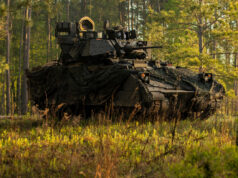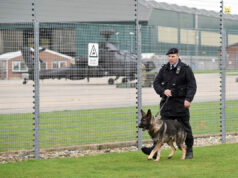Raytheon has completed testing of a ground-launched variant of its StormBreaker smart weapon, achieving the milestone just 50 days after development began, according to the company.
The test took place earlier this year at a private range in California’s Mojave Desert. A prototype weapon, fitted with a commercial off-the-shelf rocket motor, reached an altitude of around 20,000 feet and met its primary objectives.
Sam Deneke, president of Air & Space Defense Systems at Raytheon, said the rapid turnaround was enabled by reusing existing StormBreaker components. “Recent global conflicts have highlighted the need for a smart, ground-launched, precision strike weapon that can perform in GPS-contested areas,” he explained.
“StormBreaker is a composable weapon, which allows it to be customized to meet mission demands. Using the foundational components of air-launched StormBreaker allowed us to move faster than ever before, going from concept to test flight in under two months.”
The standard StormBreaker is currently fielded as an air-launched weapon, cleared for the F-15E and F/A-18E/F, with integration ongoing for the F-35A/B/C. Raytheon said the ground-launched prototype retains the ability to strike moving and stationary targets in challenging weather conditions, while offering extended range and expanded offensive roles.
The company stated it has invested heavily in independent research, facilities, and expertise to accelerate the programme. Additional ground-launch tests are planned through 2025.
Raytheon positioned the effort as part of its broader portfolio of precision strike and network-enabled weapons, intended to provide new options for U.S. and allied forces in contested environments.














Interesting to note that the US problem integrating this with F35 at short notice. Multiple UK weapons still have to wait >5 years. You have to laugh at the people that thought F35 was the smart way ahead.
Why are you telling porkies? Nowhere does the article suggest describe the integration as “short notice” let alone complete.
Instead it refers to the integration as “ongoing”. Presumably in the same way as Meteor (U.K.) and other weapons are all “ongoing”, all delayed by Block 4.
You Pro-Putin bots really need to up your game.
I hope not I prefer them being shite at their job.
👏🏻
Shite at their job is Russian SOP. 🤷🏻♂️
There is a core point that is true here, that the US Joint Program Office (JPO) responsible for F35 Weapons Integration does, in fact, drag its feet on the integration of Non-US weapons fits eg. ‘Made-in-UK’ MBDA. All weapons integration testing has to be carried out on USAF Dedicated Test F35’s. The Test Data then becomes US property, first and foremost, before being graciously disseminated back to the ‘partner’ country. Two US objectives 1/. To ensure primacy for US weapons manufacturers and 2/. ‘Control & Knowledge’ of foreign ‘partner’ weapons.
All of this brings into sharp focus the futility and stupidity of the UK ordering 12 x F35A’s as a platform for tactical nuclear attack. Only ONE tactical free-fall nuclear bomb – the US manufactured and controlled B61-12 free-fall (sorry, ‘gravity’) bomb exists for the RAF F35A. These bombs are now in restored USAF (not RAF) storage at either Lakenheath or Mildenhall, depending on which story you read.
So, back full-circle, to the main point – does anyone really believe that the ‘JPO’ would even consider the integration and testing of a future, revised, UK manufactured WE177 (A,B,C) tactical, gravity, nuclear bomb on the RAF F35A ??
I think not ! The only tactical, gravity, nuclear bomb software armingCODE that is available for the F35 is the US ‘PAL F’ , which is a 12- digit numerical arming code which, unsurprisingly, is for the US B61 – only.
All rather makes a nonsense of an airborne ‘Independent UK Tactical Nuclear’ capability.
Good point well made. Be nice to get an answer from the MoD wouldn’t it. Sounds to me like a very likely quid pro quo with Trump for something no doubt
Thank you very much and “yes” you are right it would be nice to have open clarity from the M.O.D.
The purchase of the F35A with the main purpose of “bomb-trucking” the US B61 seems to reek of ‘people pleasing’ the Pentagon.
Thank you very much and “yes” you are right it would be nice to have open clarity from the M.O.D.
Some hope of that !
Precisely. Why would do anything more than protect their own interests? The idea the U.K. might do the same is apparently pre 1940 thinking.
Interesting to note that the US had no problem integrating this with F35 at short notice. Multiple UK weapons still have to wait >5 years. You have to laugh at the people that thought F35 was the smart way ahead.
Apologies for the repeat post correcting typos!
Probably has something to do with the US operating something like 700 F-35s of different types and the UK operating 47. Unless the UK wants to pay a lot of money they are going to stay in the back of the line if they insist on using bespoke weapons.
Stormbreaker isn’t integrated on the F35, if you check the article. In fact it specifically says it’s “ongoing”.
Also “ongoing” is integration of the UK’s Meteor missile: there being an article on this site earlier this year with a photo of a Meteor inside an F35s weapons bay. In total, over 70 different types of weapons(both US and other nations) have had their integration onto the F35 held up by the Block 4 omnishambles.
I guess when you have a buy or else attitude from the Kremlin, sorry Pentagon that logic works rather well even when you are desperate for foreigners to buy your planes. I suspect it’s a lesson we mere mortals are learning fast mind and will become less easy to blackmail with but of course Trump will be able to blame another President from the sidelines if he still with us by then.
Why are you telling porkies? Nowhere does the article suggest describe the integration as “short notice” let alone complete.
Instead it refers to the integration as “ongoing”. Presumably in the same way as Meteor (U.K.) and other weapons are all “ongoing”, all delayed by Block 4.
You Pro-Putin bots really need to up your game.
Pro-Putin bot is a new one. The funniest thing I have read in a long time. I was simply commenting on the advantage of controlling who can integrate weapons, and when, on an aircraft you have no control over. Have a nice day.
You clearly don’t spend much time online if that’s the funniest thing you’ve read in a long time.
So you think lying is a valid way to criticise the fact that weapons integration is beholden to the aircraft’s manufacturer. You clearly missed your calling as a politician.
There is a core point that is true here, that the US Joint Program Office (JPO) responsible for F35 Weapons Integration does, in fact, drag its feet on the integration of Non-US weapons fits eg. ‘Made-in-UK’ MBDA. All weapons integration testing has to be carried out on USAF Dedicated Test F35’s. The Test Data then becomes US property, first and foremost, before being graciously disseminated back to the ‘partner’ country. Two US objectives 1/. To ensure primacy for US weapons manufacturers and 2/. ‘Control & Knowledge’ of foreign ‘partner’ weapons.
All of this brings into sharp focus the futility and stupidity of the UK ordering 12 x F35A’s as a platform for tactical nuclear attack. Only ONE tactical free-fall nuclear bomb – the US manufactured and controlled B61-12 free-fall (sorry, ‘gravity’) bomb exists for the RAF F35A. These bombs are now in restored USAF (not RAF) storage at either Lakenheath or Mildenhall, depending on which story you read.
So, back full-circle, to the main point – does anyone really believe that the ‘JPO’ would even consider the integration and testing of a future, revised, UK manufactured WE177 (A,B,C) tactical, gravity, nuclear bomb on the RAF F35A ??
I think not ! The only tactical, gravity, nuclear bomb software armingCODE that is available for the F35 is the US ‘PAL F’ , which is a 12- digit numerical arming code which, unsurprisingly, is for the US B61 – only.
All rather makes a nonsense of an airborne ‘Independent UK Tactical Nuclear’ capability
Looks like I was wrong in saying >5 years for many UK weapons. Reading this months Defence Analysis suggests that most of the UK F35B fleet will never be able to support Meteor and Spear 3. Just saying.
Has anyone thought of a ship launched Spear 3?
It’s been suggested several times, and I think MBDA even made CGI of it emerging from a CAMM silo a few years back, but nothing ever came of it. The closest thing now would be MBDA’s Land Precision Strike design, which I think could just about be vertically launched.
Yes, I was thinking of the EXLS that can launch CAMM or Hellfire or JAGM. Spear 3 would add extra range from that trio.
Spear 3 on ah64. We’re missing a trick. USMC are already testing something similar, Small Cruise Missile from their helicopters.